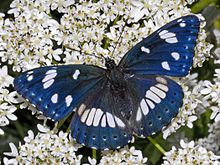Limenitis reducta
| Limenitis reducta | |
|---|---|
 |
|
| Upperside | |
 |
|
| Underside | |
| Scientific classification | |
| Kingdom: | Animalia |
| Phylum: | Arthropoda |
| Class: | Insecta |
| Order: | Lepidoptera |
| Family: | Nymphalidae |
| Genus: | Limenitis |
| Species: | L. reducta |
| Binomial name | |
|
Limenitis reducta Staudinger, 1901 |
|
| Synonyms | |
|
List
|
|
Limenitis reducta, the southern white admiral, is a butterfly of the Nymphalidae family.
This species can be found in central and southern Europe (northern Spain, southern and eastern France, Italy, the Balkans, and the Alps), in Western Asia, in Syria, the Caucasus and Iran. These butterflies live in light woodland, in woodland glades and in forest edge, at an elevation of 0–1,650 metres (0–5,413 ft) above sea level.
Limenitis reducta has a wingspan of 46–54 mm. The upperside of the wings is brown black with metallic blue shine, large transversal band of white markings and a submarginal line of small blue dots. The blue sheen varies with the angle of light. The ground colour of underside of the hindwings is red, with a silvery basal area, a row of white markings and a row of black spots. A few white cell spots are also present on the underside of the forewings. The caterpillars can reach a length of 27 millimetres (1.1 in). They are light green to dull green on the back, red brown on the underside. On the back there are numerous brown thorns.
This species is rather similar to Limenitis camilla, Neptis rivularis and Araschnia levana f. prorsa.
Dorsal side
Ventral Side
This species may have one or more generations, depending on the location. The butterfly flies from May to August depending on the location. Larvae feed on honeysuckle (Lonicera periclymenum, Lonicera etrusca, Lonicera implexa, Lonicera xylosteum, Lonicera alpigena, Lonicera nummulariifolia and Lonicera caprifolium). Adults usually feed on nectar of a wide range of herbaceous and arboreal flowers, but also visit fallen fruits, dung, aphid secretions and mineralised moisture from damp ground.
...
Wikipedia
